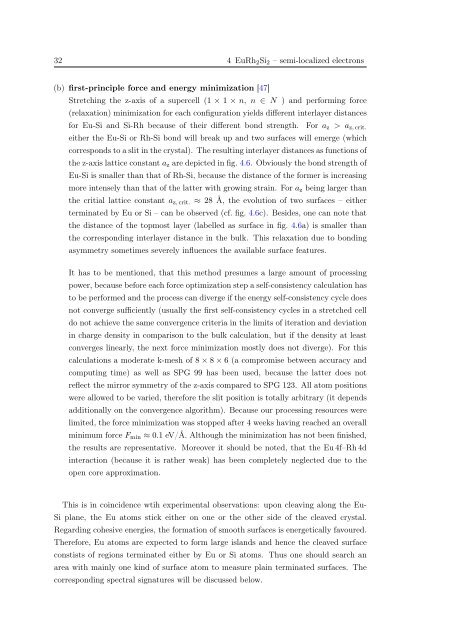Diploma - Max Planck Institute for Solid State Research
Diploma - Max Planck Institute for Solid State Research
Diploma - Max Planck Institute for Solid State Research
You also want an ePaper? Increase the reach of your titles
YUMPU automatically turns print PDFs into web optimized ePapers that Google loves.
32 4 EuRh 2 Si 2 – semi-localized electrons<br />
(b) first-principle <strong>for</strong>ce and energy minimization [47]<br />
Stretching the z-axis of a supercell (1 × 1 × n, n ∈ N ) and per<strong>for</strong>ming <strong>for</strong>ce<br />
(relaxation) minimization <strong>for</strong> each configuration yields different interlayer distances<br />
<strong>for</strong> Eu-Si and Si-Rh because of their different bond strength. For a z > a z, crit.<br />
either the Eu-Si or Rh-Si bond will break up and two surfaces will emerge (which<br />
corresponds to a slit in the crystal). The resulting interlayer distances as functions of<br />
the z-axis lattice constant a z are depicted in fig. 4.6. Obviously the bond strength of<br />
Eu-Si is smaller than that of Rh-Si, because the distance of the <strong>for</strong>mer is increasing<br />
more intensely than that of the latter with growing strain. For a z being larger than<br />
the critial lattice constant a z, crit. ≈ 28 Å, the evolution of two surfaces – either<br />
terminated by Eu or Si – can be observed (cf. fig. 4.6c). Besides, one can note that<br />
the distance of the topmost layer (labelled as surface in fig. 4.6a) is smaller than<br />
the corresponding interlayer distance in the bulk. This relaxation due to bonding<br />
asymmetry sometimes severely influences the available surface features.<br />
It has to be mentioned, that this method presumes a large amount of processing<br />
power, because be<strong>for</strong>e each <strong>for</strong>ce optimization step a self-consistency calculation has<br />
to be per<strong>for</strong>med and the process can diverge if the energy self-consistency cycle does<br />
not converge sufficiently (usually the first self-consistency cycles in a stretched cell<br />
do not achieve the same convergence criteria in the limits of iteration and deviation<br />
in charge density in comparison to the bulk calculation, but if the density at least<br />
converges linearly, the next <strong>for</strong>ce minimization mostly does not diverge). For this<br />
calculations a moderate k-mesh of 8 × 8 × 6 (a compromise between accuracy and<br />
computing time) as well as SPG 99 has been used, because the latter does not<br />
reflect the mirror symmetry of the z-axis compared to SPG 123. All atom positions<br />
were allowed to be varied, there<strong>for</strong>e the slit position is totally arbitrary (it depends<br />
additionally on the convergence algorithm). Because our processing resources were<br />
limited, the <strong>for</strong>ce minimization was stopped after 4 weeks having reached an overall<br />
minimum <strong>for</strong>ce F min ≈ 0.1 eV/Å. Although the minimization has not been finished,<br />
the results are representative. Moreover it should be noted, that the Eu 4f–Rh 4d<br />
interaction (because it is rather weak) has been completely neglected due to the<br />
open core approximation.<br />
This is in coincidence wtih experimental observations: upon cleaving along the Eu-<br />
Si plane, the Eu atoms stick either on one or the other side of the cleaved crystal.<br />
Regarding cohesive energies, the <strong>for</strong>mation of smooth surfaces is energetically favoured.<br />
There<strong>for</strong>e, Eu atoms are expected to <strong>for</strong>m large islands and hence the cleaved surface<br />
constists of regions terminated either by Eu or Si atoms. Thus one should search an<br />
area with mainly one kind of surface atom to measure plain terminated surfaces. The<br />
corresponding spectral signatures will be discussed below.
















